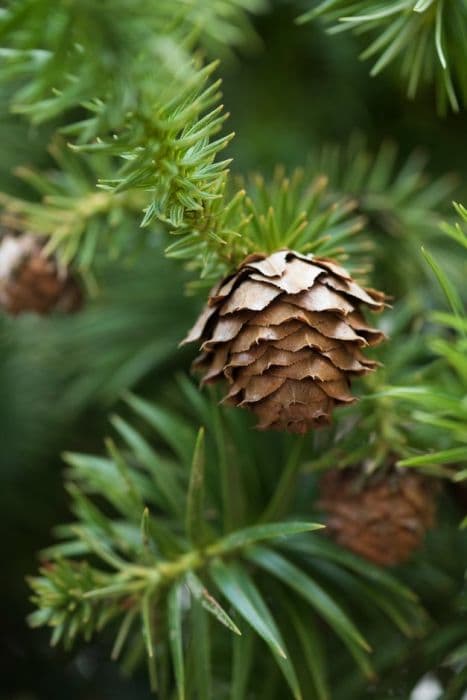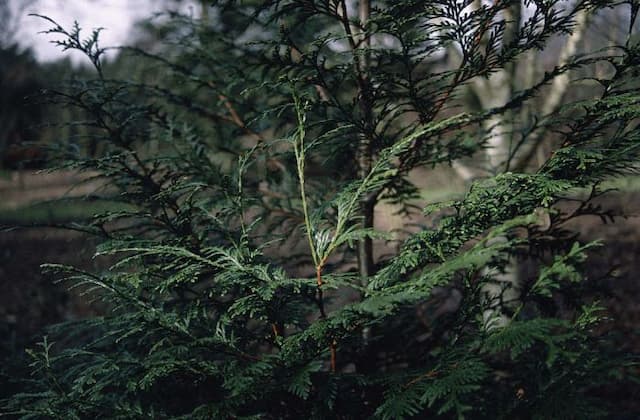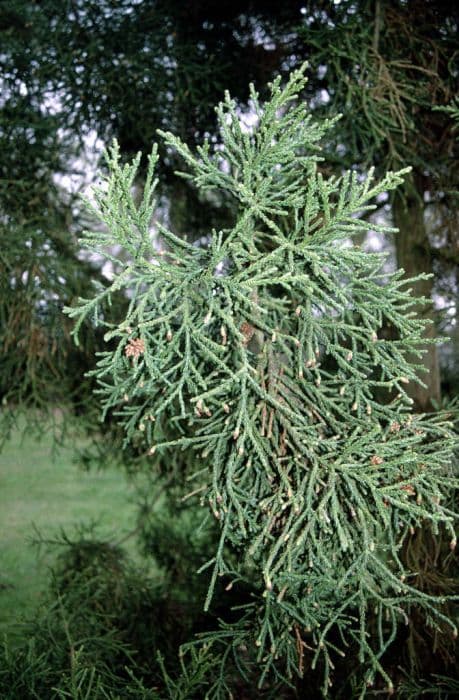Whipcord Western Red Cedar Thuja plicata 'Whipcord'

ABOUT
The 'Whipcord' is an unusual and visually striking ornamental plant known for its distinctive form and texture. Unlike the typical upright, conical shape of most of its relatives, the 'Whipcord' has a unique mop-head appearance. The foliage, rather than being flattened sprays or fans, consists of long, pendulous, cord-like branches that droop downward, giving the appearance of cascading whipcords—thus the name. The foliage of this plant is a deep, rich green color, which can add a lush, evergreen presence to any garden or landscape setting. In some climates, the green may acquire a bronze tint in the coldest winter months, adding further visual interest. The leaves are arranged in a scale-like fashion, which is characteristic of the plant, but they take on a more filamentous form that can gently sway with the breeze, creating a soft, almost hair-like effect. Overall, the 'Whipcord' has a rounded, mounding habit, creating a dome-shaped silhouette that can serve as an eye-catching feature in various garden design themes. Its textural foliage sets it apart from other plants and can be a conversation starter when included in garden landscapes. The particular growth habit and foliage type of the 'Whipcord' make it an ideal choice for those looking to add intriguing forms and year-round greenery to their outdoor spaces.
About this plant
 Names
NamesFamily
Cupressaceae
Synonyms
Whipcord Western Red Cedar, Whipcord Arborvitae
Common names
Thuja plicata 'Whipcord'.
 Toxicity
ToxicityTo humans
The Western Red Cedar, while not typically considered highly toxic to humans, can cause mild irritation when handled. Ingesting parts of this plant could potentially lead to gastrointestinal discomfort or more severe reactions in some individuals, such as diarrhea, vomiting, or abdominal pain. Prolonged exposure or significant ingestion should be avoided and medical attention sought if symptoms appear after ingestion.
To pets
For pets, the Western Red Cedar can be problematic if ingested. It contains compounds that can be toxic to animals, potentially causing symptoms like vomiting, diarrhea, abdominal pain, and drooling. If a pet consumes a considerable amount of the plant, it could lead to more severe symptoms such as muscle weakness, breathing difficulties, or changes in heart rate. Pet owners should prevent their animals from ingesting this plant and seek veterinary care if they suspect their pet has eaten any part of it.
 Characteristics
CharacteristicsLife cycle
Perennials
Foliage type
Evergreen
Color of leaves
Green
Height
4-5 feet [1.2-1.5 meters]
Spread
4-5 feet [1.2-1.5 meters]
Plant type
Shrub
Hardiness zones
5-7
Native area
North America
Benefits
 General Benefits
General Benefits- Landscape Aesthetics: 'Whipcord' Western Red Cedar offers unique visual interest with its mop-like, cord-like foliage that flows down from the branches.
- Drought Tolerance: Once established, it is relatively drought-tolerant, requiring less frequent watering, which can be beneficial in areas with water restrictions.
- Wildlife Habitat: Provides habitat and shelter for birds and other wildlife within a garden setting.
- Low Maintenance: Requires minimal pruning and care once established, making it an excellent choice for low-maintenance landscapes.
- Erosion Control: Its root system helps stabilize slopes and prevent soil erosion.
- Adaptability: Adapts well to a variety of soil types, though it prefers well-drained soils.
- Year-Round Interest: Evergreen nature ensures that it provides interest in the landscape throughout all seasons.
- Privacy Screening: Can be used for screening purposes to create private garden spaces or block unsightly views.
 Medical Properties
Medical PropertiesThis plant is not used for medical purposes.
 Air-purifying Qualities
Air-purifying QualitiesThis plant is not specifically known for air purifying qualities.
 Other Uses
Other Uses- Architectural Modeling: The Whipcord's dense foliage and unique structure make it an excellent choice for creating miniature trees and shrubs in architectural scale models.
- Crafting Bonsai: Due to its slow growth and manageable size, Whipcord is often used by bonsai enthusiasts to create living art pieces.
- Privacy Screens: Homeowners plant Whipcord hedges for creating natural privacy screens that are both effective and visually appealing.
- Garden Sculptures: The flexible branches of Whipcord can be trained into garden sculptures, contributing to the aesthetic dimension of garden design.
- Topiary Art: Whipcord is suitable for topiary, where gardeners can clip and shape the plant into various forms for decorative purposes.
- Erosion Control: Whipcord's dense root system is ideal for stabilizing slopes and controlling erosion in garden landscapes.
- Sound Barrier: When planted in a dense row, Whipcord can act as a natural sound barrier, muffling street noise and creating a quieter environment.
- Landscape Accent: Unique cascading habit of Whipcord stands out as an accent piece in rock gardens and modern landscape designs.
- Theme Gardens: Whipcord's unusual form can be a central feature in themed gardens, such as enchanted forest or fairy-tale inspired gardens.
- Photography: The unique appearance of the Whipcord is often used as a subject or backdrop in photography, particularly in macro and plant photography.
Interesting Facts
 Feng Shui
Feng ShuiThe Western Red Cedar is not used in Feng Shui practice.
 Zodiac Sign Compitability
Zodiac Sign CompitabilityThe Western Red Cedar is not used in astrology practice.
 Plant Symbolism
Plant Symbolism- Longevity and Immortality: The western red cedar, which 'Whipcord' is a cultivar of, is known for its long lifespan and durability, symbolizing everlasting life and the soul's immortality.
- Protection: Native American tribes used the western red cedar wood for totems and ritual objects, believing it would ward off evil spirits, making it a symbol of safeguarding and spiritual protection.
- Healing: The western red cedar has been used medicinally by indigenous peoples, and as such, it represents health, healing, and medicinal properties.
- Purity: The tree’s natural resistance to decay and insects confers a symbolic meaning of cleanliness and purity.
- Strength and Stability: Considering the tree’s strong wood used in construction and its ability to withstand storms, it is also symbolic of resilience, strength, and stability.
 Water
WaterThe Whipcord Western Red Cedar requires consistent moisture, but it's essential not to over-water. During the first growing season, water deeply once a week, providing about 1-2 gallons per event to establish a deep root system. Once established, reduce the frequency but ensure the soil remains moist, especially in dry conditions. In the absence of rainfall, watering every two to three weeks with 1-2 gallons should suffice. Adjust the amount based on weather conditions; more water may be needed during hot, dry spells and less during cool, wet periods.
 Light
LightWhipcord Western Red Cedars thrive in full sun to partial shade. The ideal location for this plant would be a spot where it gets at least six hours of direct sunlight per day, but it can also do well in a location with dappled sunlight. Avoid deep shade as this can affect the plant's growth and overall health.
 Temperature
TemperatureWhipcord Western Red Cedars are hardy and can tolerate a range of temperatures, typically from -20°F to 80°F. They prefer a cooler climate and can survive brief periods of colder winter temperatures, even down to -30°F. Ideally, maintaining an environment where temperatures range between 40°F and 75°F will promote healthy growth.
 Pruning
PruningPruning is primarily to maintain shape and health for the Whipcord Western Red Cedar. Light pruning can be done any time of year, but the best time for more extensive trimming is in the late winter or early spring before new growth begins. Remove any dead or damaged branches and thin out areas to allow light and air to penetrate the plant, but avoid cutting too much as this could harm the overall structure.
 Cleaning
CleaningAs needed
 Soil
SoilThe Whipcord Western Red Cedar requires well-draining soil with a mix of loam and sand, peat or compost to ensure adequate aeration. It prefers a soil pH ranging from 5.5 to 7.5.
 Repotting
RepottingWhipcord Western Red Cedar typically doesn't require frequent repotting; it should be repotted every 3 to 5 years to refresh the soil and check root health.
 Humidity & Misting
Humidity & MistingWhipcord Western Red Cedar thrives in moderate to high humidity levels but is adaptable and can tolerate the lower humidity found in most home environments.
 Suitable locations
Suitable locationsIndoor
Ensure bright light, no direct sun; rotate for even growth.
Outdoor
Plant in well-draining soil, full sun to part shade.
Hardiness zone
5-7 USDA
 Life cycle
Life cycleThe Western Red Cedar 'Whipcord' (Thuja plicata 'Whipcord') begins its life as a seed, usually germinating in a moist, well-drained soil environment. Upon germination, the seedling develops a primary root and shoots, and within a few years, the young plant establishes a sturdy root system and starts to exhibit its characteristic mop-headed foliage. As it grows, the 'Whipcord' enters a long vegetative stage, where it slowly matures over several years into a small to medium-sized shrub. During this time, it develops its unique cord-like, weeping foliage, giving it a distinctive ornamental appearance. After reaching maturity, the 'Whipcord' can produce small cones, typical of the Thuja genus, which contain seeds that, when dispersed, can give rise to new plants, thereby continuing the cycle. Throughout its lifetime, which can span several decades, the 'Whipcord' requires minimal maintenance, being relatively resistant to pests and diseases, and can survive through various climatic conditions within its hardiness zones.
 Propogation
PropogationPropogation time
Late winter to early spring
The Western Red Cedar 'Whipcord' is best propagated by semi-hardwood cuttings taken in late summer, usually between July and September. To propagate, select a healthy branch and cut a piece about 4 to 6 inches (10 to 15 centimeters) long, making sure it includes at least two sets of leaves. Remove the leaves from the bottom half of the cutting to expose the nodes. Dip the cut end in rooting hormone to encourage root development, then insert it into a pot filled with a well-draining rooting medium such as a mix of peat and perlite. Keep the cutting moist and in indirect light until it roots, which can take several weeks. Once rooted, the new Whipcord plant can be transplanted into a larger pot or outdoor space where it can grow to maturity.









